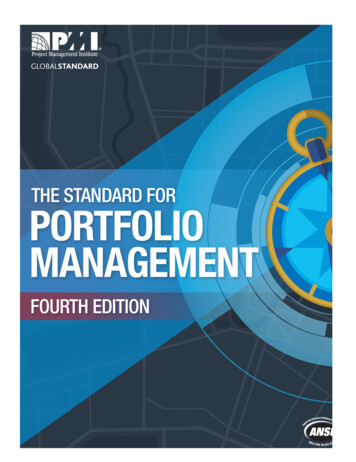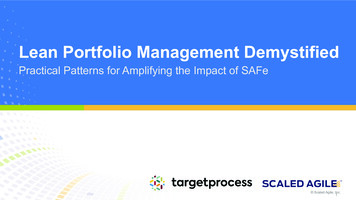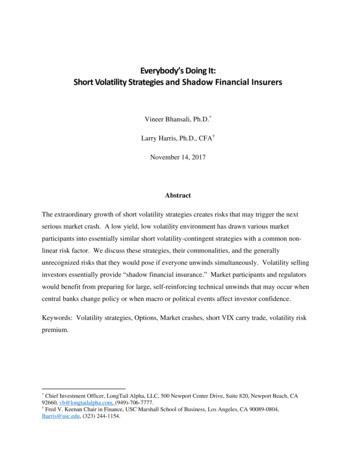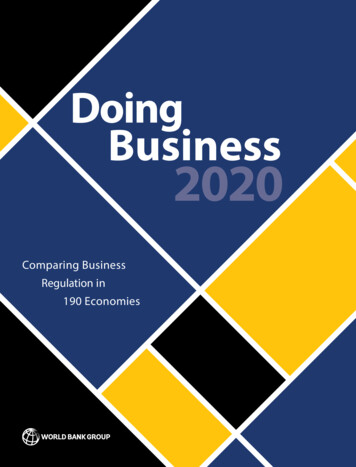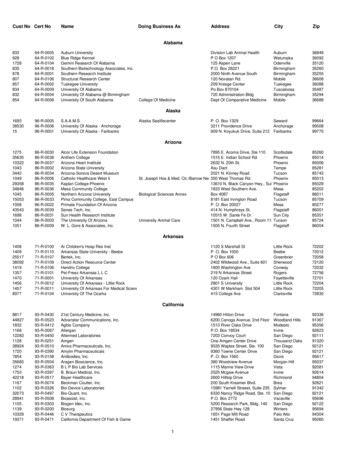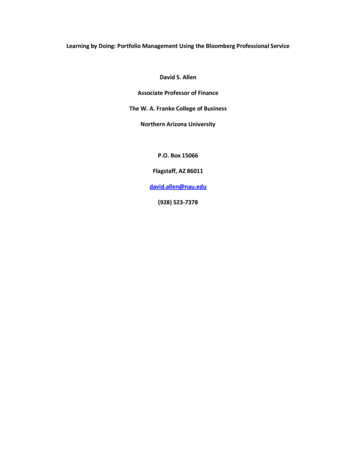
Transcription
Learning by Doing: Portfolio Management Using the Bloomberg Professional ServiceDavid S. AllenAssociate Professor of FinanceThe W. A. Franke College of BusinessNorthern Arizona UniversityP.O. Box 15066Flagstaff, AZ 86011david.allen@nau.edu(928) 523-7378
Learning by Doing: Portfolio Management Using the Bloomberg Professional ServiceABSTRACTPortfolio simulations are a popular tool used to teach students how to build, maintain, andassess security portfolios. A number of free online portfolio trackers are available, includingwww.marketwatch.com/game/, www.howthemarketworks.com, and www.google.com/finance. Forthose able and willing to pay, www.stocktrak.com is likely the most popular. However, all of theseresources come with their own set of limitations. The free sites typically do not allow students to tradebonds, options, or futures. Thus, the ability to build and assess hedge performance is severely limited.Likewise, the paid sites such as StockTrak require each student, or team of students, to pay a fee ofaround 25 to participate.In this paper, we will describe a semester-long project in which student build, maintain, andassess the performance of portfolios for specific investor objectives using the Bloomberg ProfessionalService (Bloomberg). While expensive, Bloomberg offers a much wider array of analytical tools than thetypical online simulation. Further, the author’s institution, and not the students, bears the direct cost ofproviding the resource.The simulation is intended to introduce students to a broad array of Bloomberg tools andfunctions that are applicable to portfolio management, including PRTU for creating portfolios and addingposition, and PORT for asset allocation, VaR, tracking error, and performance attribution analysis. Theend result is that students learn both the concepts of portfolio management and how to use the relatedBloomberg functions at the same time.1
PORTFOLIO MANAGEMENTIn Managing Investment Portfolios, the CFA Institute’s handbook on the subject, the portfoliomanagement process is defined as “ an integrated set of steps undertaken in a consistent manner tocreate and maintain an appropriate portfolio (combination of assets) to meet clients’ stated goals(Maginn et. al., 2007, p. 2). In this semester-long project, students will implement this process using thefollowing steps, based on the outline provided in Maginn et. al., page 2: PlanningoDefine the investment objective and identify constraints.oDevelop a strategy to achieve the objective, i.e. determine the appropriate asset allocation.ExecutionoSelect the specific securities to be used.oImplement the strategy, i.e. purchase the securities.FeedbackoMeasure and evaluate the portfolio performance.oRebalance the portfolio as needed.LEARNING OBJECTIVESThere are several learning objectives for this project. Some are Bloomberg specific, while othersfocus on investing concepts. Students are given two sample clients with different objectives: 1) incomeand 2) capital appreciation. In addition, students will be introduced to options and futures during thecourse, and will build additional portfolios that have either 3) speculation or 4) hedging as the objective.The students’ task is to build a portfolio for each of the four objectives listed above and then to monitorthe performance of each over a period of time, making adjustments as necessary to asset allocation andsecurity selection.2
Investing concept objectives:1. Learn the overall process of portfolio management.2. Learn the principles of asset allocation and security selection as they relate to the investor’sobjective.3. Learn the performance measures appropriate for each portfolio and how to interpret them.4. Learn the principles of hedging using options and futures.Bloomberg specific objectives:1. Learn how to screen stocks and bonds using tools in Bloomberg.2. Learn how to build and update portfolio positions.3. Learn how to build custom benchmarks for assessing portfolio performance.4. Learn how to use various tools in Bloomberg for measuring portfolio attributes andperformance.THE INVESTMENT OBJECTIVEThe investor’s objective is the starting point of the portfolio management process. In thisexercise, clients will give statement such as “I need to pay some expenses on a recurring basis” or “Iwant to retire in 30 years.” This, along with information about income, expenses, assets and liabilities inthe investor profile will be used to generate formal return objectives and risk objectives.3
CONSTRAINTSConstraints are typically related to circumstances unique to the investor. Each investor profilewill introduce one or more constraints related to 1) liquidity needs, 2) the investment horizon, 3) taxconsiderations and 4) ethical or social considerations. Students will need to take these constraints intoaccount in the asset allocation and security selection portion of the exercise.ASSET ALLOCATIONAsset allocation is the process of apportioning the investor’s funds across various asset classessuch as 1) money market instruments, 2) fixed income securities, 3) stocks, 4) real estate and 5) others.Academic research has shown that asset allocation is a primary determinant of the actual investmentresults over time. Brinson, Hood, and Beebower (1986), Brinson, Singer, and Beebower (1991), andIbbotson and Kaplan (2000) show that somewhere between 40% (cross-sectional) and 91.5% (over time)of returns are driven by asset allocation. An excellent source of historical asset performance data is theAsset Allocation Calculator (XAAC.xls) spreadsheet template available on Bloomberg. It allows studentsto input indexes to represent asset classes and their respective weights. The spreadsheet thencalculates historical risk and return data for each asset class, as well as overall portfolio performance.Students will use the capital market expectations (typically based on long-term historicalaverages with adjustments based on current market conditions) along with investors’ risk objective, risktolerance, and constraints to determine appropriate asset allocations. For example, one sampleinvestor will have a short-to-intermediate investment horizon and a need for periodic income. For thisinvestor, students are likely to allocate a higher proportion of funds to money market instruments andfixed income securities, and a lower proportion to stocks. A second sample investor will have no needfor periodic income, be in a higher tax bracket, and prefer capital gains over periodic income to avoidimmediate taxation. For this investor, students are likely to allocate a lower proportion of funds to4
money market instruments and fixed income securities and a higher proportion to stocks, real estate,and other less liquid assets.SECURITY SELECTIONOnce the asset allocation decision is made, the individual securities used to implement it mustbe selected. For this part of the exercise, students will use two tools in Bloomberg that allow screens: 1) SRCH for bond screening and 2) EQS for equity screening.Exhibit 1 shows how the student could screen bonds for the income portfolio using the SRCH command. A variety of screening variables are used to narrow the sample to a manageable number ofbonds.Exhibit 1. Sample bond screen using SRCH .5
To see the bonds that pass the screen, click the Results button. After identifying the bonds of interest,students can right-click on the bond and then paste it into the portfolio using the PRTU command.Equity screening is done is a similar manner using the EQS command. Exhibit 2 shows anexample of an equity screen.Exhibit 2. Sample equity screen using EQS .PORTRFOLIO CREATIONAfter the asset allocation and security selection processes are completed, the student will build theactual portfolios. The PRTU command is used both to create the portfolio structure and to enter thepositions held as of a given date. Exhibits 3 and 4 show sample portfolios for the income and capitalappreciation portfolios.6
Exhibit 3. Sample income portfolio created using PRTU .Exhibit 4. Sample capital appreciation portfolio created using PRTU .PERFORMANCE EVALUATIONBenchmarks are created using the PRTU command as seen in Exhibit 5. Benchmarks maycontain individual securities or indexes. In addition, composite benchmarks can be created in which theuser specifies either the number of shares held (or par value for bonds), or fixed weights (or floating7
weights). Exhibit 5 shows an example of a custom benchmark for a blended portfolio of 80% stocks and20% bonds.Exhibit 5. Sample composite benchmark created using PRTU .The sample income portfolio shown in Exhibit 3 would likely have a bond market index as itsbenchmark. Since the sample portfolio itself holds investment grade U.S. corporate bonds, an indexwith a similar composition is appropriate. In this case, the benchmark is a single index, rather than acomposite as was the case in Exhibit 5. An example of an appropriate benchmark for the incomeportfolio is the Dow Jones Corporate Bond Total Return Index, seen in Exhibit 6.Exhibit 6. Sample bond portfolio benchmark.8
Once the benchmark is created, it can be used with the PORT command to assess theportfolio’s performance over time. Exhibit 7 shows the performance of the income portfolio and itsbenchmark in the upper half, with the relative performance in the lower half.Exhibit 7. Income portfolio performance versus its benchmark, using the PORT command.The Bloomberg service has a number of additional tools to measure portfolio performance andidentify sources of risk within the PORT command. For example, the Holdings tab (see Exhibit 8)shows the weights, by market sector, for the portfolio and its benchmark. This allows the student toidentify potential sources of differences in risk and return for the portfolio versus its benchmark.9
Exhibit 8. Portfolio weights relative to benchmark weights.The VaR tab shows the results of a Value at Risk analysis of the portfolio relative to thebenchmark. Students can view the VaR for the portfolio as a whole, by sector, and even by individualsecurity, as seen in Exhibit 9.Exhibit 9. Value at Risk analysis of the portfolio relative to its benchmark.10
The PORT command also allows the students to perform an attribution analysis on portfolioreturns to identify why it differs from the benchmark. Exhibit 10 shows that the portfolio return was3.20% versus its benchmark return of 3.45%, for a active return of -0.26%. This active return has twocomponents: an allocation (i.e. sector weighting) return of -0.44% and a security selection (i.e. securityweighting) return of 0.18%.Exhibit 10. Attribution analysis of portfolio return relative to its benchmark.HEDGING WITH OPTIONSAs a part of this exercise, students will hedge a stock portfolio using call and put options in orderto learn the associated concepts and to gain an understanding about how these hedging techniqueswork in various market conditions. The students’ capital appreciation portfolios will be copied to newportfolios (“Equity – Call Option Hedge” and “Equity – Put Option Hedge”) and then an appropriatequantity of either calls or puts added to create the hedge. The hedge ratio equation is given by:11
portfoliovalue 1HR portfoliobeta ) (optionstrikeprice)(optionmultiplier optiondelta (1)For the initial example, we will use near-the-money options on the SPDR S&P 500 ETF (SPY) with anexpiration date of 11/22/14. On 8/1/14 the following were observed:Equity portfolio value 26,390.25Equity portfolio beta .92(from Bloomberg PORT )Closing price for the SPY EFT was 192.50Call option strike: 194.00Call option delta: 0.4564 (from Bloomberg OVME )Put option strike: 194.00Put option delta: -0.5513Using the appropriate inputs, we get the following hedge ratios:Call option HR (26,390.25 / (194)(100)) x (.92)(1/.4564) 2.75 contracts, which we will round to 3.Put option HR (26,390.25 / (194)(100)) x (.92)(1/.5513) 2.27 contracts, which we will round to 2.The results of the unhedged portfolio, along with the call hedge and put hedge portfolios are shown inExhibit 11, 12 and 13. In general, stock prices rose over the sample period as seen in Exhibit 11. For thecall hedge, as stock prices rose, the short calls went in the money, creating a loss that offset theinvestor’s gains on the stocks. Because the hedge ratio was rounded up to the nearest integer, theinvestor lost more on the calls than he made on the stocks, as seen in Exhibit 12. Finally, for the puthedge, as stock prices rose, the long puts go out of the money, so the investor has a small loss on theput that only partially offsets the profits on the stocks. This example shows students two types of riskthey face when hedging: 1) quantity risk (from rounding the number of option contracts) and 2) crosshedge risk (due to imperfect correlation between the equity portfolio and the S&P 500 index options12
used to hedge.Exhibit 11. Performance of unhedged equity portfolio.Exhibit 12. Equity portfolio with call option hedge performance.13
Exhibit 13. Performance of equity portfolio with put option hedge.HEDGING WITH FUTURESStudents will also hedge an equity portfolio using, for example, e-mini futures on the S&P 500index. The hedge ratio is given by: portfolio valueHR portfolio beta (futures contract price) (multiplier) (2)Futures contracts are larger in size than typical option contracts, so small portfolios cannot be hedgedeffectively using futures. For this example, we created a new equity portfolio that holds the same assetsas in the option hedging examples, except each position is ten times as large. Using the appropriateinputs for the December 2014 E-mini S&P 500 futures, we get the following hedge ratio:HR 263,902.50 / (1910.50)(50)) x (.92) 2.54 contracts to be sold, which we will round to 3.14
Exhibit 14. Performance of equity portfolio with futures hedge.LIMITATIONS OF
The Bloomberg service has a number of additional tools to measure portfolio performance and identify sources of risk within the PORT command. For example, the Holdings tab (see Exhibit 8) shows the weights, by market sector, for the portfolio and its benchmark. This allows the student to identify potential sources of differences in risk and return for the portfolio versus its benchmark. 10 .
